Two approaches to katsu sando, plus more Japanese sandwiches
Last week, I wrote about tonkatsu, deep fried pork cutlets, for The Japan Times. I did do several 'test cutlets' for the article, and most of them were consumed happily by Mr. Guy. He used a small one in this Guy Does Bento, and a couple ended up as katsu sando, or tonkatsu sandwiches.
You'll readily encounter in katsu sando in Japan - in konbini (convenience stores), bakeries, supermarkets and department store food halls. Katsu sando are always served cold or at room temperature, so the cutlet inside is not hot. Storebought tonkatsu sandwiches vary a lot in quality. When they're good, they are filling and delicous, but when when they're bad they can be pretty nasty.
Here are two of the better ones. They take different approaches to the question of what to do with the breaded coating.
This sandwich packet is from Maisen, a famous tonkatsu speciality restaurant in Tokyo. They use very tender Kurobuta (black pig), cut thick, and the breading is smothered in their house brand tonkatsu sauce, which is slightly sweet. By smothering the breading, the texture and flavor change. It's certainly not crispy anymore but it's quite tasty. You may also notice that even though each slice is wide, they are also fairly thick - only about 3/4 cm (1/3 inch or so) thick. That means that each mouthful is meaty and satisfying, but you don't end up feeling overstuffed afterwards.
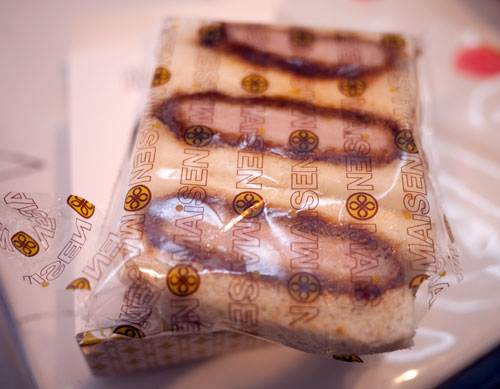
Maisen's flagship restaurant is on Omotesando in Harajuku, in a gorgeous prewar building - well worth a visit! Frommer's info here. They also sell their sandwiches and bentos at several fine department stores around the Tokyo area and in some other large cities. (Besides their katsu sando, I am partial to their menchi katsu.)
Here's another, rather unique approach. This katsu sando is from a wonderful bakery in the Motomachi section of Yokohama called Uchiki Pan. They mix sesame seeds into their panko coating, which means the coating stays crunchy even when it's cold. They only coat one side of the cutlet thinly with tonkatsu sauce (I am not sure, but I think they just use the standard 'Bulldog' brand). The finely shredded cabbage also adds crunch. I think this is my favorite katsu sando.
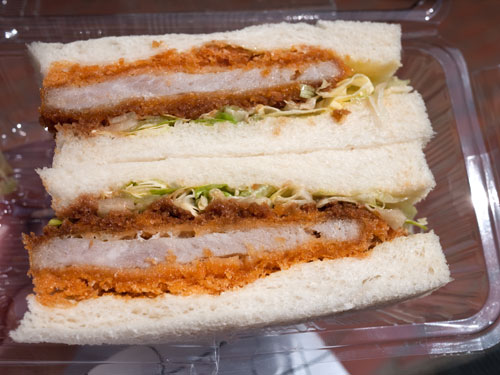
Incidentally, Uchiki Pan is one of the oldest bakeries in Japan, founded in 1888. I'll write them up in another article (probably over on Just Hungry). Here's their sandwich display around 11am; by 12, they are mostly sold out.
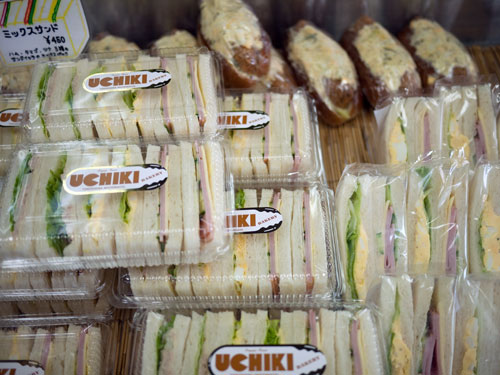
Some other Japanese sandwiches
As you may have guessed by now, sandwiches are called 'sando' in Japanese. (Which reminds me: years ago when I lived and worked in Manhattan, I used to pass by a small Japanese restaurant/deli that displayed a sign in their window proudly proclaiming in English: "We have: Chicken Sand, Crab Sand, Potato Salad Sand!" I'm sure that must have confused a lot of people.)
Sandwiches are just as ubiquitous in Japan as onigiri or bento boxes, and are a popular choice for lunch. (If you go to Japan and become sick of rice, there's no reason to fear: bread is readily available!) Japanese sandwiches almost always use the same kind of bread - sliced shokupan or English-style loaf bread. White bread is the norm, though brown and whole grain bread is making slow inroads. (A recent interesting development on the bread front is bread made from rice flour.)
Here's the most basic of sandwiches, shaki shaki (crispy) ham sandwiches from 7-11. Costing only 220 yen, it's quite delicious with paper-thin, slightly sweet ham and crispy iceberg lettuce. Perhaps not the most nutrious of sandwiches, but I am rather addicted to them. In the background you see a packet of "mixed" sandwiches costing 250 yen: a ham and egg, a ham and cheese, and a tuna.

These ham sandwiches are of a higher class. For sale in the Shinkansen if you leave from Tokyo Station, they're delicate sandwiches made from Kurobuta pork ham from a famous charcuterie in Kamakura. Just bread spread with mustard-butter and ham, but so good. (The yellow ones are disappointingly mediocre cheese. It's hard getting really good cheese in Japan.)
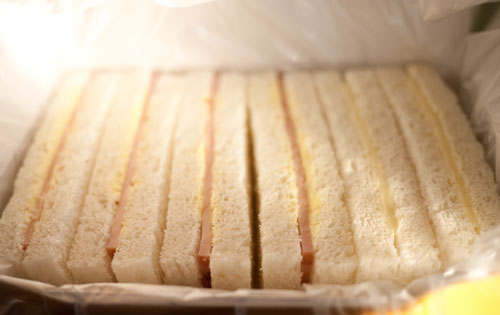
Finally, these may be my favorite sandwiches in the world. They are certain up there, and are my favorite egg sandwiches for sure. They're from Shinshindo, another venerable bakery, this time in Kyoto. The egg is cooked to a just-beyond-very-runny softboil stage - I'm guessing 4 to 5 minutes - and very roughly chopped up, so that every mouthful is an eggy delight. Note the two-tone bread too.
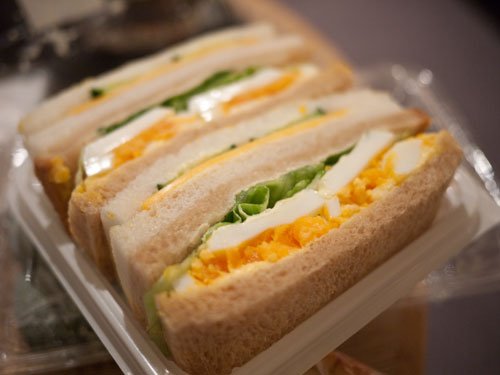
I happen to think that Japanese sandwiches are the best. But my (Japanese) mother disagrees vehemently. She says Swiss sandwiches, especially the ones from Confiserie Sprüngli on Zürich, are the best. She periodically sends me photos she took of Sprüngli sandwiches out of the blue by email, saying she dreams of them. We both laugh at each other for our sandwich obsessions.
What's your favorite sandwich? (Bonus points if you share a photo or a link to one. ^_^)
If you enjoyed this article, please consider supporting this site by becoming my patron via Patreon.
